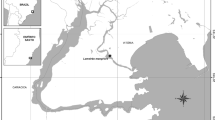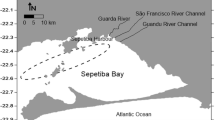Abstract
The dynamics of lead (Pb) and cadmium (Cd) accumulation in juvenile Porcellio scaber were studied over 6 months after exposing them to three different concentrations of lead and cadmium in their food. Subsequently the ability of P. scaber to eliminate lead and cadmium was studied over two months. Growth was measured to determine whether metal contamination leads to physiological stress in the animals. The accumulation of Pb and Cd in P. scaber shows two different phases. Up to the age of 2–3 months the assimilation exceeds the rate of growth and leads to rapidly increasing concentrations. After 3 months the rate of accumulation is proportional to the rate of growth and the heavy metal concentrations remain on a stabilized level. P. scaber was able to eliminate about 40% of the assimilated lead within 2 weeks but there was no elimination of Cd within 7 weeks. Contaminated P. scaber shows significant growth reduction. The physiological response of P. scaber to heavy metal contamination is discussed.
Similar content being viewed by others
References
Coughtrey, P. J., Martin, M. H., Young, E. W.: 1977, Chemosphere 6(12), 827.
Dallinger, R. and Prosi, F.: 1988, Cell Biol. Toxicol. 4(1), 97.
Dallinger, R., Berger, B. and Birkel, S.: 1992, Oecologia 89, 32.
Donker, M. H.: 1992, Funct. Ecol. 6, 445.
Grobenski, Z. and Völlkopf, U.: 1994, Improvements in Graphite Furnace Tubes, Perkin-Elmer AS Lab. Notes 47/E.
Hames, C. A. C. and Hopkin, S. P.: 1989, J. Zoology 217, 599.
Hames, C. A. C. and Hopkin, S. P.: 1991a, Can. J. Zool. 69, 1931.
Hames, C. A. C. and Hopkin, S. P.: 1991b, Bull. Environ. Contam. Toxicol. 47, 440.
Heck, M., Rink, U. and Weigmann, G.: 1995, Z. Ökologie u. Naturschutz 4, 75.
Hopkin, S. P.: 1989, Ecophysiology of Metals in Terrestrial Invertebrates, Pollution Monitoring Series, Ed.: Kenneth Mellanby Elsevier Applied Science, London.
Hopkin, S. P.: 1990a, J. Appl. Ecol. 27, 460.
Hopkin, S. P.: 1990b, Funct. Ecol. 4, 321.
Hopkin, S. P., Hames, C. A. C. and Dray, A.: 1989a, Micro. Analyses23.
Hopkin, S. P., Hames, C. A. C. and Bragg, S.: 1989b, Monitore Zool. Ital.(N.S.) Monogr. 4, 477.
Hopkin, S. P., Hardisty, G. N. and Martin, M. H.: 1986, Environ. Pollut.(Ser. B) 11, 271.
Hopkin, S. P. and Martin, M. H.: 1982a, Oecologia(Berl.) 54, 227.
Hopkin, S. P. and Martin, M. H.: 1982b, Tissue Cell 14(4), 703.
Hopkin, S. P. and Martin, M. H.: 1984, Symp. Zool. Soc. Lond. 53, 143.
Hopkin, S. P. and Martin, M. H.: 1985, Sci. Food Agric. 36(7), 538.
Jones, D. T. and Hopkin, S. P.: 1991, 'Biological Monitoring of Metall Pollution in Terrestrial Ecosystems', in Ravera, O. (ed.), Terrestrial and Aquatic Ecosystems, Pertubation and Recovery, pp. 148-152.
Joosse, E. N. G. and van Vliet, L. H. H.: 1984, Pedobiologia 26, 249.
Martin, M. H. and Coughtrey, P. J.: 1975, Chemosphere 4(3), 155.
Martin, M. H. and Coughtrey, P. J.: 1976, Chemosphere 5(1), 15.
Martin, M. H., Coughtrey, P. J. and Young, E. W.: 1976, Chemosphere 5, 313.
Niboer, E. and Richardson, D. H. S.: 1980, Environ. Pollut. 1B, 3.
Prosi, F. and Dallinger, R.: 1988, Cell Biol. Toxicol. 4(1), 81.
Prosi, F., Storch, V. and Janssen, H. H.: 1983, Zoomorphology 102, 53.
van Cappelleveen, E. H. E.: 1985, 'Ecotoxicity of Zn and Cd for Terrestrial Isopods', in Int. Conf. Heavy Metals in the Environment, Athen, p. 245.
van Capelleveen, E. H. E.: 1983, 'Effects of Iron and Mangenese on Isopods', Int. Conf. Heavy Metals in the Environment, Heidelberg, p. 666.
Wieser, W.: 1965, Pedobiologia 5, 304.
Wieser, W.: 1966, Helgoländer wiss. Meeresunters.14, 326.
Wieser, W., Busch, G. and Buchel, L.: 1976, Oecologia(Berl.) 23, 104.
Wieser, W., Dallinger, R. and Busch, G.: 1977, Oecologia 30, 265.
Williamson, P.: 1979, Oecologia 44, 75.
Witkus, R., Morgan, M. J., Dowling, R., Klein, M. and Faso, L.: 1987, Comp. Biochem. Physiol. 87C(1), 149.
Witzel, B.: 1989, Z. angew. Zool. 3, 303.
Witzel, B.: 1992, 'Die Eignung von Porcellio scaber Latr.(Isopoda) zum aktiven Monitoring von Bleiund Cadmiumimmissionen in anthropogen belasteten Ökosystemen', Ph. D. thesis, Free University Berlin.
Zauke, G. P.: 1982, Pol. Arch. Hydrobiol. 29(2), 289.
Author information
Authors and Affiliations
Rights and permissions
About this article
Cite this article
Witzel, B. Uptake, Storage and Loss of Cadmium and Lead in the Woodlouse Porcellio scaber (Crustacea, Isopoda). Water, Air, & Soil Pollution 108, 51–68 (1998). https://doi.org/10.1023/A:1005086123969
Issue Date:
DOI: https://doi.org/10.1023/A:1005086123969




